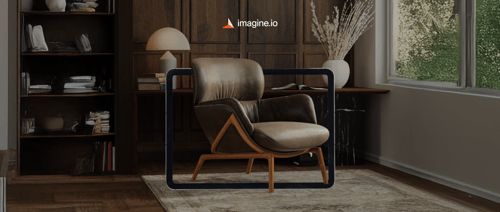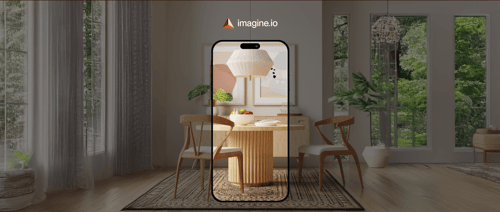In a bustling Los Angeles design studio, a team huddles around a screen, tweaking a digital chair model switching fabrics, adjusting curves, and spinning it in 360 degrees, all in real time. The result is a photorealistic rendering, indistinguishable from a studio shot, created in minutes. A decade ago, this process would have demanded weeks of physical prototypes, costly photoshoots, and endless revisions. Now, imagine.io and similar AI-powered platforms are transforming furniture design, slashing timelines for manufacturers and retailers across the U.S. and Canada, from High Point's furniture hub to New York's retail epicenter.
Revolutionizing Furniture Prototyping with AI
The traditional furniture prototyping process was a grind. Designers sketched concepts, crafted physical mock-ups, staged photoshoots, and waited for stakeholder approvals a cycle that could stretch months. Each iteration meant more materials, labor, and delays. Today, AI-driven visualization tools are rewriting the playbook. By uploading a 3D model to a cloud-based platform, brands can generate high-fidelity images, videos, or interactive configurators in minutes, not weeks. This speed is a lifeline for companies in competitive markets like Chicago, Dallas, and Las Vegas, where staying ahead demands agility.
The numbers underscore the shift. The interior design software market, valued at $8.26 billion in 2024, is expected to climb to $14.90 billion by 2034, growing at a 6.82% CAGR from 2025 to 2034. Cloud-based solutions and the push for sustainable, efficient design tools are driving this boom, enabling professionals to streamline workflows while delivering functional, eco-conscious results. Remote work and virtual collaboration further amplify the need for dynamic, accessible platforms that power interactive design environments.
Key Trends in AI-Driven Furniture Design
Cloud-Based Prototyping Takes Over
Physical prototypes are becoming relics. Cloud-based platforms let designers upload 3D models and produce assets instantly, a boon for brands in furniture hubs like High Point or Austin. This digital-first approach scales effortlessly, allowing companies to generate visuals for entire collections without the logistical headaches of physical samples. For retailers like Ruggable or SertaSimmons, this means faster iterations and broader creative freedom.
Photorealistic Visuals That Rival Reality
AI-generated renderings are so precise they fool even seasoned eCommerce leaders. Tests by imagine.io reveal that experts often can't distinguish these visuals from traditional photoshoots. Whether it's capturing the sheen of a Kohler faucet or the texture of a King Koil mattress, these high-fidelity outputs are redefining marketing for brands across the U.S. and Canada, delivering studio-quality results without the studio price tag.
Versatile Content for Omnichannel Strategies
Modern retail demands more than static images. Brands need dynamic content videos for Instagram, 360-degree views for websites, configurators for in-store kiosks. AI platforms deliver all these from a single model, ensuring consistency across LinkedIn, YouTube, and eCommerce platforms. For companies like KitchenAid or Kichler, this unified approach simplifies content creation, saving time and amplifying reach in competitive markets.
Real-World Impact: AI in Action
Residential Furniture Gets a Speed Boost
Imagine a sofa brand launching a new line. With AI visualization, they can test countless fabric swatches, colors, and shapes in hours, not weeks. Retailers like Ruggable leverage these tools to keep catalogs fresh, letting customers visualize products in their homes before purchase. This agility accelerates launches and enhances buyer confidence, especially in eCommerce-driven markets like New York and Los Angeles.
Hospitality and Commercial Precision
In Las Vegas, a hotel chain reimagining its lobby uses AI to test furniture layouts digitally, ensuring every piece fits before committing to bulk orders. This precision minimizes costly errors and aligns with tight project timelines. For commercial clients, platforms like imagine.io offer a way to visualize complex setups, from restaurant seating to office configurations, with unmatched efficiency.
Showroom Innovation Through Configurators
Retail showrooms are evolving. Brands like Hunter Fan deploy 3D configurators, letting customers customize furniture on the fly swap upholstery, adjust dimensions, see it in their space. This interactive experience, powered by AI, bridges online and in-store shopping, driving sales in markets like Chicago and Dallas, where personalization is a key differentiator.
Overcoming Barriers to AI Adoption
Subscription Models Spark Debate
Not all brands are ready to embrace AI. Some resist imagine.io's subscription-based pricing, favoring one-off project fees. While subscriptions unlock unlimited asset creation ideal for high-volume catalogs smaller firms in Canada or Austin may find the ongoing commitment daunting. Clear value propositions, like speed and scalability, are key to winning them over.
Navigating Custom Pricing
Unlike competitors with fixed rates, imagine.io tailors pricing to each client's needs. This flexibility maximizes value but can feel complex for companies accustomed to simpler models. Transparent communication about cost savings and output potential helps address this objection, particularly for brands managing large SKUs.
Legacy System Challenges
Adopting AI requires a digital foundation. Teams without robust 3D model pipelines common in older furniture businesses face integration hurdles. Transitioning to cloud-based workflows demands upfront investment in training or tools, but as cloud adoption grows, these barriers are fading, especially for forward-thinking firms in tech-savvy regions like New York.
The Business Case for AI in Furniture Design
Accelerating Time-to-Market
AI's greatest strength is speed. Processes that once took months design, prototyping, photography now wrap in days or hours. For brands like PepsiCo, using furniture for branded events, or Diageo, crafting bespoke retail displays, this agility is a competitive edge. Faster launches mean quicker market penetration, critical in fast-paced regions like Las Vegas.
Saving on Physical Prototypes
Physical mock-ups drain budgets. AI eliminates multiple rounds of samples, cutting material and labor costs significantly. Mid-sized brands in Dallas or Canada, balancing innovation with tight budgets, find this particularly compelling. The savings free up resources for bolder designs or expanded marketing.
Scaling for Large Catalogs
Retailers with thousands of SKUs, like Kohler or KegWorks, face constant pressure to keep visuals current. AI platforms offer unlimited asset generation, enabling seamless updates across sprawling catalogs. This scalability ensures brands stay relevant in eCommerce, where fresh content drives clicks and conversions.
The Future of Furniture Design: AI as a Creative Catalyst
AI isn't just speeding up furniture design it's redefining creativity. The AI interior design platform market is surging, driven by demand for personalized, efficient, and sustainable solutions. Algorithms enable automated space planning, optimal furniture placement, and real-time visualizations, boosting productivity while sparking innovation. From boutique studios to global brands, early adopters are gaining a competitive edge.
Consider IKEA's foray into generative AI, as reported by Yanko Design. By feeding vintage catalogs into AI tools, their design partner, Space10, crafted futuristic concepts that could inspire future collections. This isn't about replacing designers but empowering them to push boundaries. For furniture brands in the U.S. and Canada, platforms like imagine.io offer a clear path forward: harness AI to streamline workflows, cut costs, and unleash creativity. The question isn't whether to adopt AI it's how quickly you can start.
Frequently Asked Questions
How is AI transforming furniture prototyping timelines?
AI-powered visualization platforms are revolutionizing furniture prototyping by reducing timelines from months to minutes. Traditional processes that required weeks of physical prototypes, costly photoshoots, and endless revisions can now be completed digitally through cloud-based platforms. By uploading a 3D model, brands can generate photorealistic images, videos, and interactive configurators instantly, enabling faster iterations and market launches.
What are the main benefits of using AI for furniture design and visualization?
AI furniture design platforms offer three key advantages: dramatically accelerated time-to-market (processes now take days instead of months), significant cost savings by eliminating multiple rounds of physical prototypes, and unlimited scalability for large catalogs with thousands of SKUs. These tools also generate versatile content for omnichannel marketing strategies, creating everything from social media videos to interactive website configurators from a single 3D model.
Are AI-generated furniture renderings as good as traditional photography?
Yes, AI-generated furniture renderings have reached photorealistic quality that rivals traditional studio photography. Tests reveal that even seasoned eCommerce experts often cannot distinguish AI-generated visuals from conventional photoshoots. These high-fidelity outputs can capture intricate details like fabric textures and material sheens while delivering studio-quality results without the associated costs and time constraints of physical photography setups.
Disclaimer: The above helpful resources content contains personal opinions and experiences. The information provided is for general knowledge and does not constitute professional advice.
You may also be interested in: 3D Rendering Software for Designers - Imagine.io
Struggling with expensive, outdated product visuals that slow down your creative process and stunt eCommerce growth? imagine.io's AI-powered platform empowers furniture, home décor, and textile brands to effortlessly produce striking 3D images, immersive videos, AR experiences, and interactive configurators. Cut production costs up to 70%, boost conversions 5X, speed up prototyping, and supercharge your online sales. Ready to elevate your product visuals and captivate customers? Book a demo with imagine.io today!
Powered by flareAI.co




.png?width=500&name=How%20to%20Add%20a%203D%20Product%20Configurator%20to%20Your%20WordPress%20Website%20(Complete%20B2B%20Guide).png)
















%20(1).png?width=500&name=Why%20Exploded%20Mattress%20Views%20Matter%20(And%20How%20to%20Generate%20Them)%20(1).png)
.png?width=500&name=Best%20Shopify%20Product%20Configurator_%20How%20to%20Choose%20the%20Right%20One%20(2).png)
.png?width=500&name=Why%20Exploded%20Mattress%20Views%20Matter%20(And%20How%20to%20Generate%20Them).png)



.png?width=500&name=Best%20Shopify%20Product%20Configurator_%20How%20to%20Choose%20the%20Right%20One%20(1).png)







.png?width=500&name=How%203D%20Rendering%20Can%20Make%20or%20Break%20Your%20Industrial%20Design%20Pitch%20(1).png)








%20with%20Digital%20Twins%20and%203D%20Visualization.png?width=500&name=Optimizing%20Your%20Digital%20Asset%20Management%20(DAM)%20with%20Digital%20Twins%20and%203D%20Visualization.png)




.png?width=500&name=Styling%20Home%20Decor%20for%202025_%20From%20Global%20Influences%20to%20Playful%20Personalization%20(1).png)
